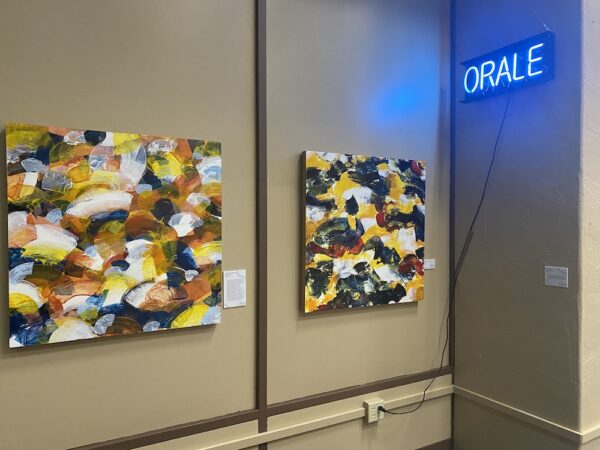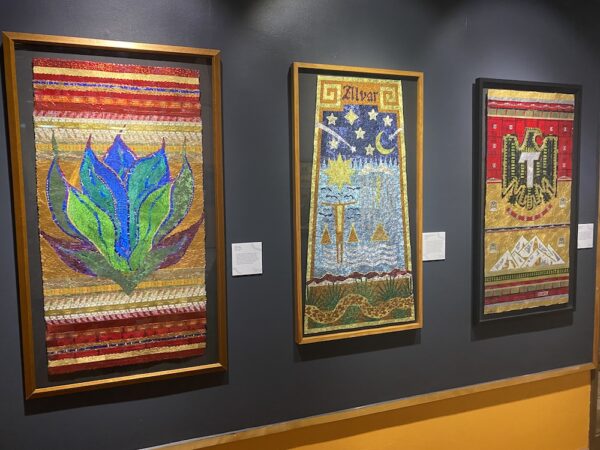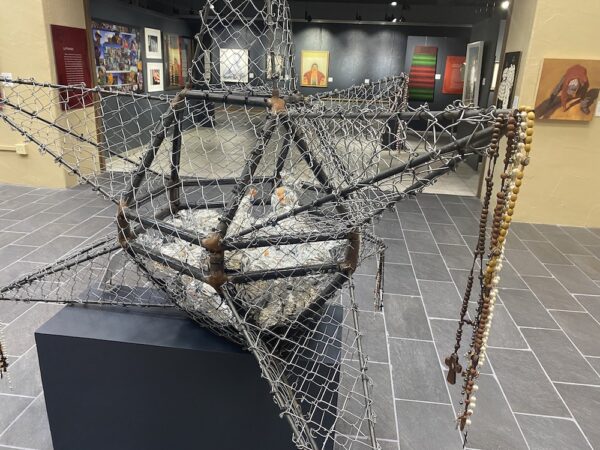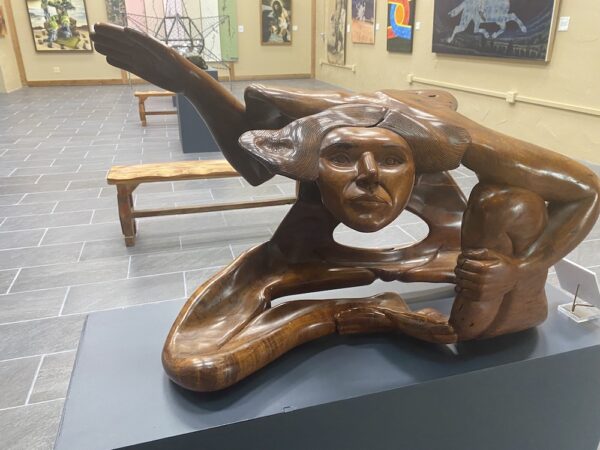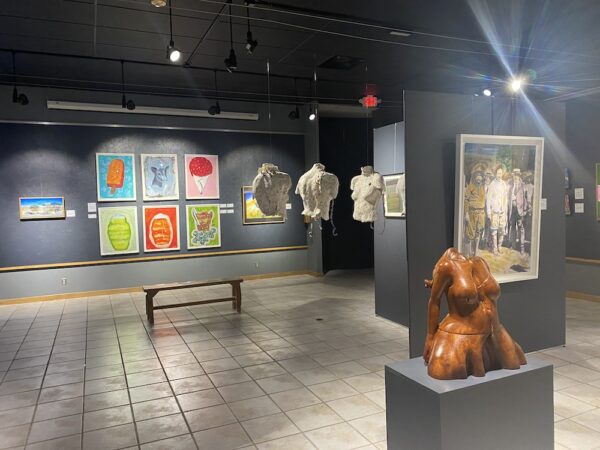
Installation view of Icons and Symbols of the Borderland, Art from the US-Mexico Crossroads at the Carlsbad Museum and Art Center. All photos by Hannah Dean.
As a last hurrah for the 2021 summer art season, my daughter and I drove to Carlsbad, New Mexico to visit Icons and Symbols of the Borderland, Art from the US-Mexico Crossroads at the Carlsbad Museum and Art Center. The show, curated by Diana Molina, consists of work from El Paso art group JUNTOS Art Association, and is divided into four rooms with the themes Environment, La Frontera, Comida y Bebida, and Sacred and Profane. The roster includes some of my favorite Texas artists — Alejandro Macias! Benito Huerta! César Martinez! (And upon viewing Icons, many more to add to that list.) Beyond the killer line up, I was immediately taken by the exhibition’s layout, material variety, and exciting work. I’m still mulling over Icons, and will make sure to return to this space for future exhibitions.
Greeting me in the first themed room of the exhibition, “Environment,” was a modestly-sized diptych in a corner nook by Tina Fuentes, my former painting professor at Texas Tech University. The paintings, Nube Colorada y Gente (Red Cloud and People), are scraped into being with primary colors that fan and etch across the surface forming rainbows, or a macro-view of sand. The closer you get the work, the more dynamic and aggressive the lines, the paste of the paint reminding you of the physical effort it takes to make such a stroke — a total body experience. The pieces hold true to the painterly quality of Fuentes’s repertoire but certainly show a shift in the expression, as though her focus on the thunderous atmosphere has infused her work with a force all its own.
This exhibition, over all, is a master-class in surfaces, and while much of the work shares mutual themes or homage, or is didactic in nature, the materiality of every single piece is the truest common denominator. From the juicy brushwork in Victoria Suescum’s Cabrito to the gilded Dos Equis-wrapper collages in curator/artist Diana Molina and César Martinez’s work, to Mark Clark’s vibrant street scenes and hyper-smooth portraits by Gaspar Enriquez, the exhibition is a sensory touchstone.
It’s the locative nature of the works in the “Environment” and “La Frontera” rooms that held my focus. Angel Cabrales’ work, a sort of portal between “Environment” and “La Frontera,” is a large chain-link star piñata full of baby dolls wrapped in foil. The points of the star are draped with rosary beads (“thoughts and prayers!”)… . Please know that there’s nothing quite like seeing heavy work with your five-year, who implores you to go — Rambo-style — actually do something about kids in cages, you-freaking-monster. I wish that my flimsy answer of “I voted for someone who would do something about it” were not so hollow. And it turns out, a straight-up lie! Separated families are still detained en masse less than an hour from where we live. (Note: Carlsbad has just announced that one of its living centers will be transformed into a “processing center” in the coming weeks.) Cabrales’ work especially gets at the heartstrings of politics in this place.
The piece that greets and acts as sentinel over the entirety of the exhibition is powerful: Jose Luis Rivera-Barrera’s mesquite wood carving, Tijerina (Scissor). The title card describes the artist sussing out what was contained in the wood, reclaiming the lost woman inside. The tunnel formed by Tijerina’s limbs twist in and out of herself and space — existing through strength, beauty, and a forward gaze. There is a fluid quality to the sculpture, interrupted by natural pocks of the wood like wounds in her flesh. Even so, from some angles it appears as though the woman is surfacing from water; the dips and dives in her form are merely ripples in water and yet her anatomy is somehow totally correct. This sculpture is the perfect introduction to the complexity, grace, (ir)reverence, and humanity of the entire exhibition.
“Icons and Symbols of the Borderland” is on view at Carlsbad Museum and Art Center (New Mexico) through September 30, 2021. Admission is free. On September 18, in conjunction with short films, poetry, and art by JUNTOS, conductor Simon Gollo and the NMSA Philharmonic Orchestra will perform as part of “Border Traditions and Celebration!”


